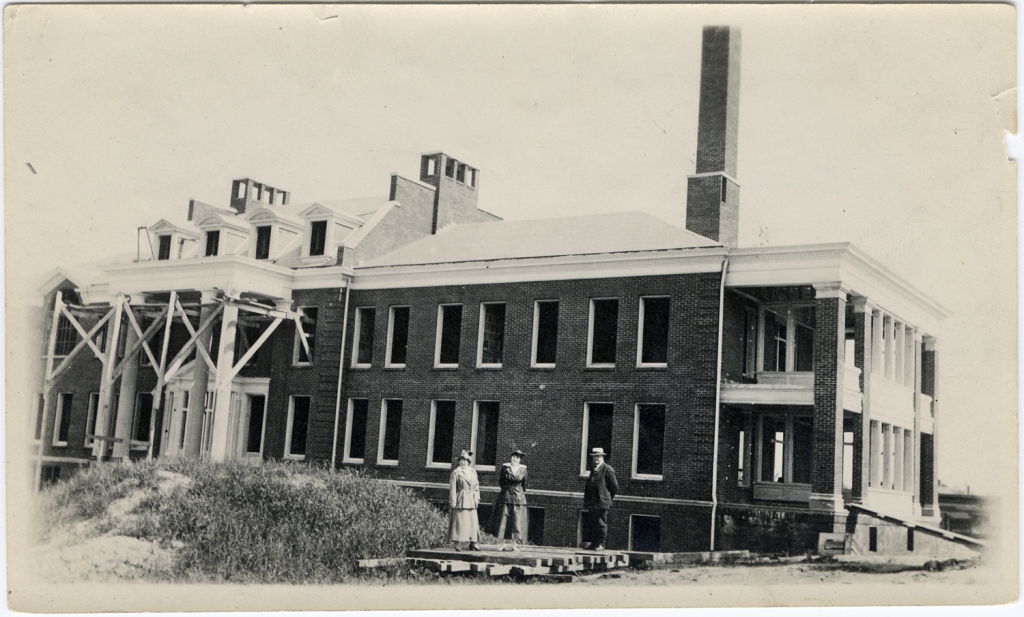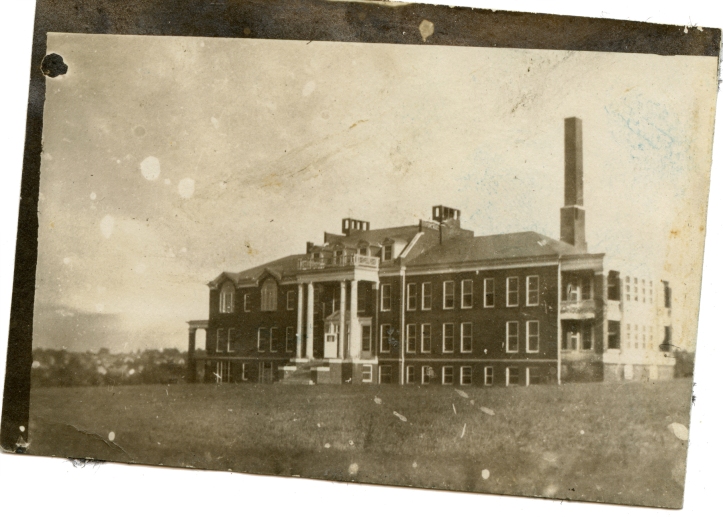
When the new Mansfield General Hospital officially admitted its first patient, the whole staff came out to pose next to the ambulance, and the guy with the fractured leg sat up on his stretcher and smiled at the camera. That was on May 22, 1918. It was a beautiful new state-of-the-art facility, and had plenty of empty beds.
It had taken four years to build the new institution, and there certainly didn’t seem to be any urgency to rush it to completion. The old Emergency Hospital on Third Street had served the community well for generations, and many thought a new facility was an extravagant waste of resources. No one could have imagined that within only 150 days later the grand new place would be too small.
Turns out, the doors opened just in time.

Emergence
The Emergency Hospital had been established on Third Street in 1902 when diptheria and smallpox were making the rounds of Mansfield, but when typhoid came to pay a visit a decade later folks were uneasy that the city’s sickroom was so close to downtown.
So in 1914 the city stepped up to protect itself by finding a new site out on the edge of town for a modern hospital. Civic leaders proposed a goal of raising $100,000 in ten days for the project. They ended up with 5,875 pledges totaling $154,750.



Advance Notice
The headlines of early 1918 spent volumes of ink passing news to readers about the Great War being waged in Europe. Aside from all the bullets flying ‘over there’ that threatened Mansfield boys in the US Expeditionary Forces, there was equally horrifying news of all the germs overrunning the battlefields, trenches and Army Red Cross tents in France and Germany.
As many soldiers were dropping from disease as from warfare.
Even more alarming was when the germs invaded the coasts of America and the invisible shadow of contagion began stalking the nation ‘over here.’
This new threat was an old, familiar nemesis come back to visit with an updated name. The last time this virus tackled the US, in 1888, they called it “The Grip.” That time it was a strain of influenza that came to us from Russia. This cousin who came to call in 1918 was a virus that originated in Spain, so it became known as The Spanish Influenza.

Proliferation
In early autumn, Mansfield health officials were cautiously breathing a sigh of relief that somehow our city had dodged the bullet that was impacting other cities in Ohio.
On October 4 they were proud to publish a headline, ‘Not One Case.’
On October 5, there were 25 cases.
By October 8, local doctors estimated no fewer than 400 cases in Mansfield.
On October 9 they put posters in saloons and cigar stores that issued warnings against loitering. There were 30 new cases, and 32 the next day.
On October 19 there were 49 Mansfielders who died within 24 hours, and the city went into full quarantine. They closed churches, schools, theaters and streetcars. Handbills posted around town specified that “Lodges, Dances, Socials, Entertainments and Every Kind of Meeting or Assembly is Prohibited.”
When the epidemic began in early October, the governing board of Mansfield General Hospital decided they could allocate 4 beds for Flu victims, imagining this would protect other patients from contagion. On the 19th, they made room for 30 more.
At the Mansfield Reformatory there were 73 cases.


Quiet City
On October 24, there were 300 to 400 inmates at OSR with the flu. Mansfield General Hospital shuffled chairs out of waiting areas, replaced them with cots, and admitted 149 fever cases.
On November 1, all businesses in the city were ordered to close at 7 PM, with the only exceptions being telephone and telegraph offices, and the Railroad stations.
Jesse Black’s diary November 2, 1918 read:
No streetcars today. The city is still as a picture preserved in a glass paperweight. The crows brag like it’s their neighborhood now.




On November 5, polling places were open on Election Day. The Health Board discussed the possibility of gradually lifting the quarantine.
On November 7, the Reformatory dug its 17th grave in 17 days.
On November 9, the city’s streetcars resumed running on their regular schedule.
On Sunday, November 10, Churches were allowed to hold services for everyone over 16 years old.
The Dream
On November 18, the first day when no new cases were reported, the quarantine was lifted. City schools opened their doors. Folks were free at last to loiter once again in saloons.
They say if a summer storm starts suddenly as a downpour, it will end just as suddenly. That was how the Mansfield epidemic happened: as swiftly as it arrived in town, it was unexpectedly over.
There was never an official tally released of how many in the city fell to the Spanish Influenza, but news reports later referred back to 1918 as the time when “over 100 died.”
People back then used to have an expression in conversation that you don’t hear much any more: they spoke of something as a ‘fever dream.’ It meant that some event was so weird and non-sensically disorienting that it could only have been imagined in sleep as a dream while burning off a fever. If they thought you were making up some crazy story they would roll their eyes and say, “Sounds like a fever dream.” Like it couldn’t really happen.
In the generation after 1918, that is the exact expression they used to describe the forty days when Mansfield took part in the great American Flu Epidemic.
PS. Sentiments in the Diary
Jesse Black was married to the man who owned the Ohio Brass Company, and if anyone was in a position to ignore the consequences of Mansfield’s flu epidemic it would have been her; yet she helped cook emergency quarantine meals at the Elks Club kitchen, and supervised drivers who delivered that food to the Flats. This is what Jesse had to say in her diary about the October fever of 1918:
I think when the Lord sends us these awful moments, they come as gifts, because otherwise how would we ever see how much we all care for each other? How could we know enough to be grateful for the simple power to draw breath?


A century ago most people pulled together in a catastrophe. Today most people pull each other apart.
In the post card showing 2 buildings, my parents told me that the building on the left was for nursing students. Was that true?
LikeLike
Yes it was. My mother graduated in 1946 when it was starting all the additions. She told me that during her schooling she with other students lived on the top floor. Interesting note: I have her notebooks from her training. The first couple pages included instructing them about flowers the patients received and the proper care of them. She would go to work for Dr. P.O. Staker full time until 1963ish, but she would be found behind the desk helping when my siblings or I were in for an appointment. Then I ended up graduating from there in 1995. The school is now out on Trimble Road and is part of Ashland University.
And Thank You to Timothy Brian McKee for the work you do on the history of Mansfield.
LikeLike
Yes. That is the nursing school. I graduated in 1970
LikeLike
Yes, my cousin attended & graduated a Registered Nurse from Mansfield General Hospital & I remember that the nursing school was on the left.
LikeLike
All these pictures bring back so many memories. I wasn’t around in 1918 when the Spanish Flu took many lives. I do remember learning a great deal about the devastation it caused. My mother worked at the hospital in the late 60’s. I really wish Mansfield was great like it use to be. I guess the ole saying holds true, “Nothing lasts forever.” If I was in a position to move back to Mansfield, I would in a heartbeat.
LikeLike
I also worked at Mansfield General after graduating in June, 1959 from a similar 3 year hospital-based nursing school in Dayton, OH; however, it was not altogether a pleasant experience.
I do love Ohio, and especially my hometown Mansfield & would move back if I didn’t have children and grandchildren in California.
LikeLike
I remember visiting the Lantz Cemetery outside of Mansfield & a relative pointed out the top right section on the hillside as where many of the deceased victims of the 1918 flu epidemic were buried.
LikeLike
Thanks for posting interesting
LikeLike
Very interesting. I hope the history of this Corona Virus can be added to this compilation and how we are strongly encouraged to practice distance socialization to help end the pandemic. This history brings into perspective what mankind endures to perpetuate the will to live with Gods help.
LikeLike
Very interesting thanks for sharing
LikeLike